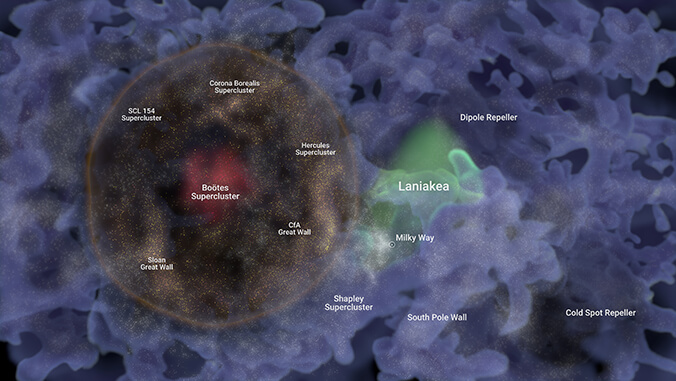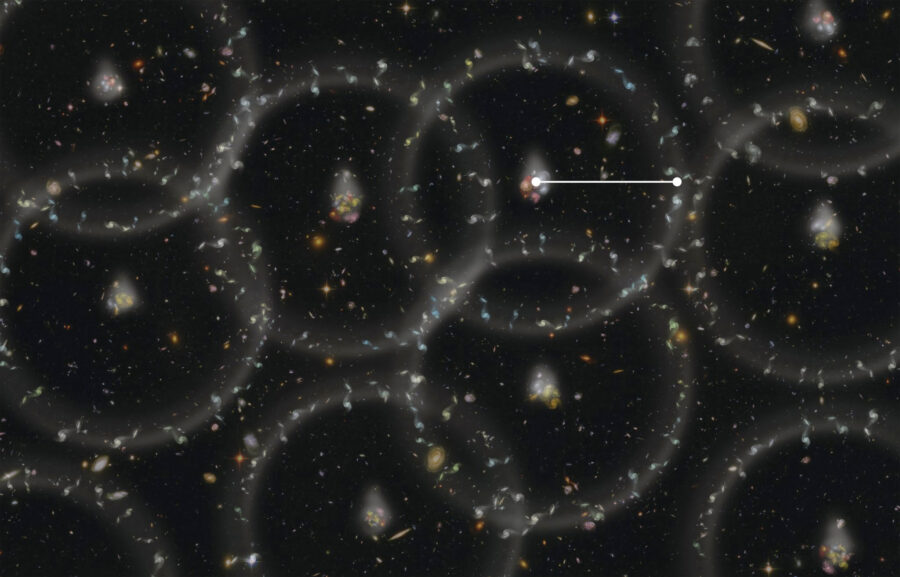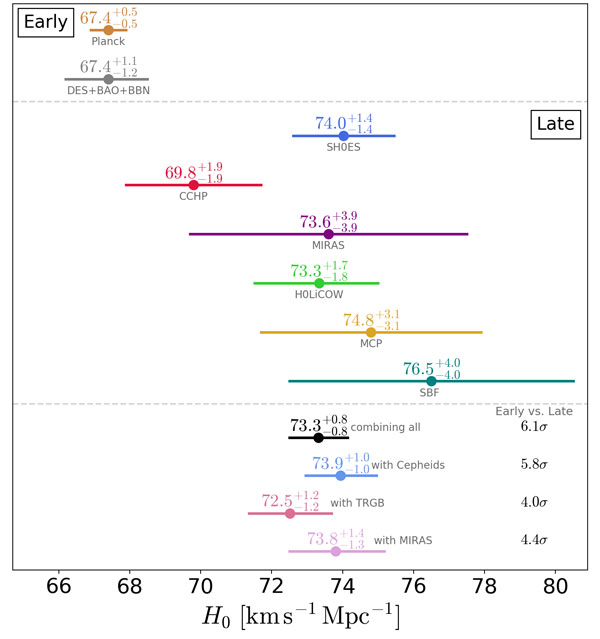A newfound cosmic alignment of galaxies challenges fundamental ideas about the nature of our universe.

Frédéric Durillon / Animea Studio / Daniel Pomarède (IRFU, CEA University Paris-Saclay)
Astronomers mapping the precise distances to tens of thousands of galaxies have found a curious cosmic structure. Galaxies by the thousands lie along a spherical shell that spans 1 billion light-years. The size alone is enough to challenge fundamental ideas about the universe.
Brent Tully (University of Hawaii) and his colleagues happened on the structure while mapping 55,877 galaxies in the local universe as part of a project known as Cosmicflows-4. “We were not looking for it,” Tully explains. “It is so huge that it spills to the edges of the sector of the sky that we were analyzing.” The structure itself, however, had been previously discovered by Maret Einasto and colleagues in 2016, as reported in Astronomy & Astrophysics.
As Tully and colleagues mapped out galaxy positions, they couldn’t help but notice the giant sphere take shape. All around the sphere, the astronomers saw familiar structures, previously discovered in other sky surveys, such as the Sloan Great Wall, the Center for Astrophysics Great Wall, and the Hercules-Corona Borealis Great Wall. Each of these walls is itself made of clusters of hundreds or thousands of galaxies.
“It was an amazing process to construct this map and see how the giant shell structure . . . is composed of elements that were identified in the past as being themselves some of the largest structures of the universe,” says cartographer Daniel Pomarede (Paris-Saclay University).
The scales involved are truly grand: The galactic walls that make up the sphere are themselves millions or even a billion light-years long. Meanwhile, the sphere’s interior is sparse and contains the Boötes Void. Only in the very center does the number of galaxies increase again, due to a collection of galaxy clusters known as the Boötes Supercluster.
The whole sphere lies about 820 million light-years away from us, well outside the Laniākea Supercluster that encompasses the Milky Way Galaxy as well as all of the Local Group that we’re part of. (Tully’s team discovered Laniākea in 2014.)
Explore the sphere with this 3D visualization:
The astronomers worked in partnership with Hawaiian language professor Larry Kimura (University of Hawaii) and Kaʻiu Kimura, director of the ʻImiloa Visitor Center to name the giant galactic sphere Ho‘oleilana. The word stems from a line of the Kumulipo creation chant: “Hoʻoleilei ka lana a ka Pōuliuli,” meaning “From deep darkness come murmurs of awakening.” Ho‘oleilana is drawn from this chant and means “sent murmurs of awakening.”
Origins of the Sphere
The building blocks of Ho‘oleilana are galaxies, which in turn group into clusters and superclusters. Each individual galaxy is couched in dark matter, and dark matter rules the larger groupings via gravity. So, it is possible that the sphere simply grew out of the gravitational mingling of matter. Those interactions have, over time, organized galaxies into a cosmic foam, in which galaxies tend to lie along walls and filaments that outline large regions of mostly empty space known as voids. It could be that the galactic sphere is simply a natural outcome of that process.
However, Tully and colleagues have an alternative suggestion, published in the Astrophysical Journal. They think this spherical structure might be the echo of huge pressure waves that sloshed around the early universe. Known as baryon acoustic oscillations, these waves came about because the early universe was filled with a dense hot plasma not unlike the Sun’s interior. Gravity drew plasma together in denser regions, but photons trapped with the matter tried to push it apart. The result was a sloshing primordial soup.
Eventually, the ions and electrons of the plasma combined to form neutral gas, freeing photons to fly on their merry way. But the effects of the sloshing remained. As the gas collapsed to form stars and galaxies, the waves imprinted a sort of pattern, like ripples in a pond, that then expanded along with the universe over cosmic time. Tully’s team thinks that Ho‘oleilana might be a single one of these ripples, frozen in space.

Zosia Rostomian / Lawrence Berkeley NationalLaboratory)
Not everybody agrees with this conclusion, though. Imagine scattering pebbles into a pond — the resulting ripples would overlap so that the ripple around a single pebble’s drop would be difficult if not impossible to distinguish. Previous studies have found evidence of baryon acoustic oscillations, but only on a statistical basis, by studying huge populations of galaxies.
“The theoretical expectation has been that the density enhancements in individual BAO would be too weak to be registered,” Tully acknowledges.
The only way that a single such ripple might be discerned, Tully and colleagues argue, is if the mass at the center of the ripple were exceptionally dense, like throwing a larger stone into a pond otherwise riddled with pebbles. “We first identified the Ho‘oleilana shell without thinking about what might be at the center,” Tully says. “It was pleasing to find a rich supercluster there.”
A future test of the BAO scenario might be to see if this supercluster really contains enough mass to engender a ripple of its own.
If the sphere comes from a primordial slosh, then with a few mathematical equations astronomers can relate the width of the sphere directly to the current expansion rate of the universe. The sphere is unexpectedly large, about 10% bigger than the BAOs found in statistical studies. As a result, Tully’s team finds a current expansion rate of the universe that’s somewhat high.
(For those interested in the numbers: The Hubble constant they find is 76.9 kilometers per second per megaparsec, but with possible values ranging from 72.1 to 85.1 km/s/Mpc. Other studies have found values between 68 to 73 km/s/Mpc.)

Vivien Bonvin / HOLiCOW Team
Regardless of Ho‘oleilana’s origin, its sheer size challenges a fundamental idea about how the universe is laid out. While we expect gravitationally organized structure on scales up to some 500 million light-years across, at larger scales astronomers think the universe should start to become relatively smooth. That is, as you slowly zoom out on a map of galaxies, you’d initially make out groups and bubbles and voids, but then everything would start to blend together.
At 1 billion light-years wide, Ho‘oleilana pushes that notion of homogeneity to larger scales, Tully says: “Evidence such as Ho‘oleilana indeed suggests the scale to reach homogeneity is greater.”
Editorial note: The article has been edited to credit discovery of the giant shell of galaxies, now known as Ho'oleilana, to Maret Einasto and her colleagues in 2016.
 9
9









Comments
Rod
September 14, 2023 at 4:44 pm
H0 is bouncing 🙂 My note. H0=76.9 km/s/Mpc is a much higher value than 67 or 68 km/s/Mpc. Using Ned Wright calculator, H0=76.9 km/s/Mpc and z=0, "It is now 12.420 Gyr since the Big Bang. The age at redshift z was 12.420 Gyr." The universe age shrinks to less than 12.5E+9 years old [Using this calculator, https://www.kempner.net/cosmic.php, z=0 and H0 = 76.9 km/s/Mpc, "age of the Universe at z = 12.0567 Gyr".
Another recent report using JWST and Cepheids indicate H0 some 73 or 74 km/s/Mpc.
Ref - Crowded No More: The Accuracy of the Hubble Constant Tested with High Resolution Observations of Cepheids by JWST, https://arxiv.org/abs/2307.15806, 28-July-2023.
You must be logged in to post a comment.
jpb.astro
September 15, 2023 at 5:11 pm
The age of the universe for a given H0 depends on the other cosmological parameters. In the standard Lambda-CDM model, the other parameters that affect the age are the total matter density Omega_m and the energy density of the cosmological constant Omega_L. Those two are linked such that Omega_m+Omega_L = 1, but you get very different ages for Omega_m=0.25 vs 0.35. If you depart from pure LCDM, including something like Early Dark Energy to resolve the Hubble tension, the changes in age can become much larger.
You must be logged in to post a comment.
namrats66
September 15, 2023 at 5:03 pm
Does this mean the Hubble Constant is a function of location, especially w.r.t. BAOs?
You must be logged in to post a comment.
Monica YoungPost Author
September 26, 2023 at 4:25 pm
Hi namrats,
The Hubble constant is the *current* rate of expansion of the universe. So, no, it is not a function of location but rather of time. It's the expansion rate right now. When astronomers measure the width of baryon acoustic oscillations over time, they are measuring the expansion rate not just right now but also what it used to be at earlier times. That's why it's such a powerful measurement to make!
~ Monica
You must be logged in to post a comment.
Anthony Barreiro
September 15, 2023 at 8:18 pm
Thank you for this clear explanation of a really fascinating discovery. 55,877 galaxies! That's a big data set. I'm a big fan of astronomers who actually look at stuff in the sky, rather than just making models in their computers, although I know modeling and theorizing are important too. If this bubble is a single baryon acoustic oscillation, that is truly awe-inspiring.
I wish the features in the 3D image were labeled as they are in the 2D image.
You must be logged in to post a comment.
Maret
September 16, 2023 at 1:59 am
Ho'oleilana is not alone - it is the most prominent of six intertwined shell-like structures presented by Maret Einasto and her co-authors in Astronomy & Astrophysics in 2016 (https://ui.adsabs.harvard.edu/abs/2016A%26A...587A.116E/abstract). We are very happy that this structure has now been found also by Brent Tully and his coauthors using CosmicFlows data. We described Ho'oleilana earlier in M. Einasto et al. 2011 (https://ui.adsabs.harvard.edu/abs/2011A%26A...532A...5E/abstract) as three chains of very rich superclusters.
Also, M. Einasto et al. (2015) briefly presented another shell-like structure centered at the very rich Abell cluster A2142 (https://ui.adsabs.harvard.edu/abs/2015A%26A...580A..69E/abstract). All these shells are part of a quasiregular network of rich clusters and superclusters. first presented by Einasto et al. in 1994 (https://ui.adsabs.harvard.edu/abs/1994MNRAS.269..301E/abstract), with characteristic scale of approximately 120 - 140 h-1 Mpc. This scale is seen also as a "bump" in the power spectrum of rich galaxy clusters, (https://ui.adsabs.harvard.edu/abs/1997Natur.385..139E/abstract), and as "wiggles" in the correlation function of galaxy clusters: https://ui.adsabs.harvard.edu/abs/1997MNRAS.289..801E/abstract)
However, Einasto et al. did not associate these structures with BAO phenomenon since these structures are too rich for BAO phenomenon. However, weak
BAO shells have been discovered in the distribution of galaxies by Arnalte-Mur et al. 2012, https://ui.adsabs.harvard.edu/abs/2012A%26A...542A..34A/abstract.
These shells are centered at luminous galaxies, as expected from the BAO phenomenon.
You must be logged in to post a comment.
Anthony Barreiro
September 16, 2023 at 6:37 pm
Thanks. You've been doing this for a while!
You must be logged in to post a comment.
Brian of DRAA
November 7, 2023 at 9:07 am
Please help! Regarding the statement "The sphere is unexpectedly large, about 10% bigger than the BAOs found in statistical studies", I thought this wasn't a very big discrepancy. My understanding is that the BAO was established by the Heisenberg Uncertainty principal in the very early universe (first second after the Big Bang) at the end of the Inflation epoch. I though BAO was best represented by the power spectrum of the CMB as seen by Planck (and COBE and WMAP before Planck) and has led to the spacing of the galaxies and voids we see today (as per this article). 10% too large would simply be a large BAO “bubble” verses the norm over the “spectrum” of Heisenberg Uncertainties associated with end of the Inflaton force. Hence 10% is not a big deal, just a statistical anomaly. Any clarification/correction to my mental model would be appreciated. Brian
You must be logged in to post a comment.
Monica YoungPost Author
November 8, 2023 at 10:43 am
The BAOs come from the sloshing of the photon-plasma mixture that existed in the very young universe, but while there are no doubt quantum effects involved in understanding those motions, I don't know the specific role of the Heisenberg Uncertainty Principle in those calculations. Sorry I can't be more help on that front!
The issue with the 10% larger radius is that it doesn't match the previously determined size of BAOs. Those previous estimates were statistically determined, but the scale of the BAO is a set number. The sound waves all travel the same distance, so if one is looking for spheres, there is only one right answer.
You must be logged in to post a comment.
You must be logged in to post a comment.